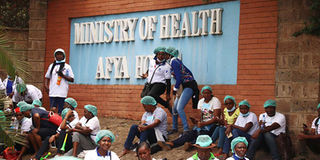Breaking News: At least 10 feared to have drowned in Makueni river
Immunisation has suffered under weight of medics’ strikes

Nurses hold a sit-in Afya House, Nairobi County, on September 11, 2017. The prolonged health workers’ industrial action last year has cost the country its gains in immunisation coverage. PHOTO | FILE | NATION MEDIA GROUP.
What you need to know:
It is estimated 500,000 children were not vaccinated against some of the world’s most debilitating diseases, including polio, pneumonia, meningitis, measles, influenza and hepatitis.
These diseases, long identified as among the biggest health threats in the region, could ravage the nation in the coming years if these hordes of vulnerable children are exposed to their vectors.
According to the Economic Survey 2018, the coverage last year dropped by eight per cent from 1,101,279 (69 per cent) immunised children in 2016 to 1,014,894 (63 per cent) in 2017.
The prolonged health workers’ industrial action last year has cost the country its gains in immunisation coverage with Kenya recording a 15-year low of 63 per cent, exposing children under one year to diseases such as polio, pneumonia and tuberculosis.
According to the Economic Survey 2018, the coverage last year dropped by eight per cent from 1,101,279 (69 per cent) immunised children in 2016 to 1,014,894 (63 per cent) in 2017.
The 2017 figure is the lowest coverage since 2005 when it stood at the same level. During this period, the survey noted, most of the counties experienced a decrease in the coverage with only 10 experiencing an increase.
COVERAGE
The highest decrease in coverage occurred in Narok and Nyamira counties at 24.1 and 22.3 per cent respectively, while Laikipia and Turkana counties had the highest increase at 22.9 and 16.5 per cent respectively. The lowest coverage was recorded in Mandera County at 25.4 per cent in 2017.
Tana River, Wajir, Mandera, Isiolo, Samburu, Narok, Trans Nzoia and West Pokot counties had more than half of children under one un-immunised.
Nyamira recorded a drop of 22.3 per cent to 66 per cent from the 89.1 per cent coverage a year earlier.
DEBILITATING
Healthcare services in all public facilities countrywide ground to a halt last year when nurses went on strike between June and November 2017 that lasted for 152 days. This industrial action came hot on the heels of the doctors’ strike which took 100 days from December 5, 2016, to March 14, 2017.
As a result, it is estimated 500,000 children were not vaccinated against some of the world’s most debilitating diseases, including polio, pneumonia, meningitis, measles, influenza and hepatitis.
These diseases, long identified as among the biggest health threats in the region, could ravage the nation in the coming years if these hordes of vulnerable children are exposed to their vectors.
According to the findings by the Human Resources for Health (HRH) Kenya, between the months of July and September last year when there was no strike, the faith-based organisations immunised only 590 children against measles and 602 on Oral Polio Vaccine.
Full immunisation refers to children below one year who have received one dose of BCG, another of measles and three doses each of Oral Polio Vaccine (OPV) and pentavalent, pneumococcal vaccines.
COMPULSORY
When a child misses a polio vaccine for instance and attack happens, the likelihood of that child going down with the virus is huge.
The World Health Organisation (WHO) recommends an oral polio vaccine dose immediately a baby is born — called a zero dose — followed by a series of three primary doses and a minimum one inactivated dose.
However, the Economic Survey shows that half of children below one year in eight counties did not receive the compulsory vaccination.
In October, the Health ministry raised the alarm over the rising number of children missing compulsory vaccines due to the nurses’ strike.
The ministry then moved to launch a drive to vaccinate more than 300,000 children and mothers in arid and semi-arid counties who missed the vaccines for diseases including tetanus, BCG, measles and influenza.





